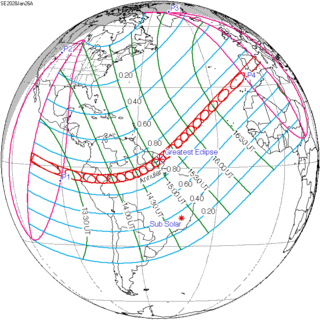| Solar eclipse of January 26, 2028 | |
|---|---|
| Type of eclipse | |
| Nature | Annular |
| Gamma | 0.3901 |
| Magnitude | 0.9208 |
| Maximum eclipse | |
| Duration | 627 s (10 min 27 s) |
| Coordinates | 3°00′N 51°30′W / 3°N 51.5°W |
| Max. width of band | 323 km (201 mi) |
| Times (UTC) | |
| Greatest eclipse | 15:08:59 |
| References | |
| Saros | 141 (24 of 70) |
| Catalog # (SE5000) | 9569 |
An annular solar eclipse will occur at the Moon's ascending node of orbit on Wednesday, January 26, 2028,[1] with a magnitude of 0.9208. A solar eclipse occurs when the Moon passes between Earth and the Sun, thereby totally or partly obscuring the image of the Sun for a viewer on Earth. An annular solar eclipse occurs when the Moon's apparent diameter is smaller than the Sun's, blocking most of the Sun's light and causing the Sun to look like an annulus (ring). An annular eclipse appears as a partial eclipse over a region of the Earth thousands of kilometres wide. Occurring about 2 days before apogee (on January 28, 2028, at 15:30 UTC), the Moon's apparent diameter will be smaller.[2]
The path of annularity will pass through Ecuador, Peru, northern Brazil, and French Guiana. It will then travel across the Atlantic Ocean and end in southern Portugal, northern Morocco, and southern Spain. A partial eclipse will be visible over much of central and northern South America, Central America, the Caribbean, eastern North America and Western Europe, and West Africa.
- ^ "January 26, 2028 Annular Solar Eclipse". timeanddate. Retrieved 13 August 2024.
- ^ "Moon Distances for London, United Kingdom, England". timeanddate. Retrieved 13 August 2024.
